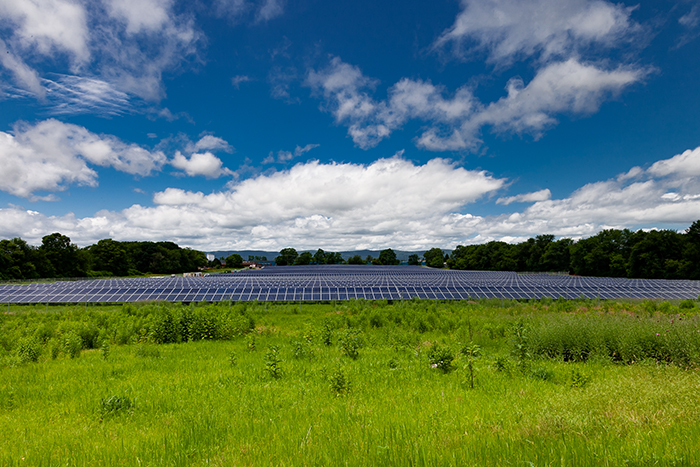Dickinson College Part of Unprecedented Renewable Energy Purchase

Combined with Dickinson’s Tesla-designed-and-built 3-megawatt solar field (pictured) and multiple other solar arrays on campus, the new power purchase agreement eradicates approximately 75% of Dickinson’s electricity-related emissions.
Dickinson partners with three schools to purchase energy from 200+ acre solar farm
Dickinson College is again leading the way in sustainable campus operations by announcing its partnership in an unprecedented purchase of renewable energy. Together with Lafayette College, Lehigh University and Muhlenberg College, Dickinson will be purchasing the largest amount of solar power of any group of independent higher education institutions nationally. The schools also represent the first group of colleges and universities in Pennsylvania to enter into a power purchasing agreement. The announcement was made at Second Nature’s 2020 Higher Education Climate Leadership Summit.
The schools have signed a 15-year virtual power purchase agreement (VPPA) to buy renewable energy that will be generated by a newly constructed 200+ acre solar farm located in Texas. Fewer than 50 of the nation's approximately 4,200 higher education institutions have initiated new large-scale renewable energy projects. The new solar farm will be the 12th largest higher education renewable energy project in terms of megawatts and, because it will be built as a result of this purchase, it will add additional renewable energy to the country's grid.
“The actions that these schools have taken illustrates true leadership, a collaborative approach to reducing greenhouse gas emissions, and provides an example of how other campuses can meet their individual climate goals and support the transition of the electricity grid to cleaner sources of power,” said Timothy Carter, president of Second Nature.
The schools began collaborating in pursuit of a renewable energy project in January 2019, aiming to advance sustainability interests among premier academic institutions in Pennsylvania and serve as an example of how a mix of mid-sized and small institutions can aggregate together to leverage greater purchasing power.
For Dickinson, the project, combined with the 3 megawatt solar field and multiple other solar arrays on campus, eradicates approximately 75% of electricity-related emissions “… and a large percentage of our total carbon footprint,” says Ken Shultes ’89, associate vice president of sustainability and facilities planning. Collectively, the group’s 45.9 megawatt share of the project is anticipated to help prevent over 70,000 metric tons of carbon emissions each year, which is equivalent to removing over 15,000 cars from the road or the amount of carbon sequestered by nearly 85,000 acres of forest. The VPPA partnership, along with other Climate Action Plan initiatives at each campus, will enable each institution to meet its carbon neutrality goals.
“This year, Dickinson is achieving its carbon neutrality goal, but we can’t stop there. Colleges and universities must continue innovating and leading in this area,” said Dickinson College President Margee M. Ensign. “This solar power partnership with three other Pennsylvania institutions provides an opportunity to promote a large-scale renewable energy project and obtain the associated renewable energy credits in a way that is financially sustainable and provides educational opportunities for students.”
The schools engaged CustomerFirst Renewables, a renewable energy advisor, to competitively source and contract for a renewable energy solution to reduce greenhouse gas emissions. “Aggregating demand enabled this group of mid-sized and small buyers to cost-effectively access the environmental and social benefits of renewables, positioning these schools as true sustainability leaders among higher education institutions, large and small,” said CustomerFirst Renewables CEO Gary Farha.
The group evaluated each potential renewable energy project across myriad factors, including environmental impact, grid-avoided emissions impact, project economics, project developer credentials, development risk, and education and research opportunities provided to students. Though the schools were initially focused on contracting for a local project, analysis indicated that, due to the more carbon-intensive fuel mix of the Texas grid, a Texas-based project would result in roughly 15% more avoided emissions than a project sited in the local mid-Atlantic grid. As a result, they opted for the additional environmental impact of the Texas project. The project carries the additional benefit of being sited on barren land, allowing the group to avoid the tree clearing or farm displacement often required for mid-Atlantic-based projects.
As part of the education and research opportunities, the project developer will conduct rotating guest lectures at each of the four institutions. In addition, two students will be selected each summer for internships with the renewable energy developer for eight years. The schools will also have access to real-time production data from the solar asset for research purposes at each institution.
TAKE THE NEXT STEPS
Published February 24, 2020